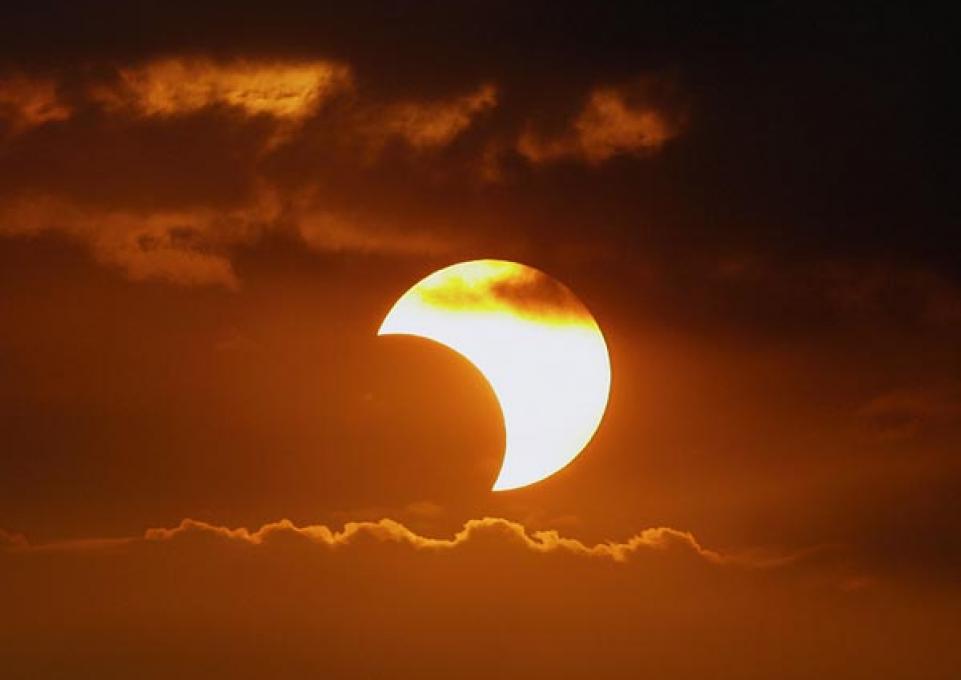
Buffalo State has been designated an “Eclipse Official Viewing Location” by NASA for the solar eclipse that will take place on Monday, August 21. In the “path of totality,” a 70-mile-wide arc stretching from Oregon to South Carolina, viewers will watch a total eclipse as the moon passes in front of the sun. Here in Western New York, viewers will see the moon blot out about three-fourths of the sun.
The eclipse is generating excitement across the country. Here in Western New York, Kevin Williams, associate professor of earth sciences and science education and director of the Whitworth Ferguson Planetarium, has been working for months to spread the word—as well as eclipse glasses—to the local community. Last April, Buffalo State hosted a training event for the Buffalo Eclipse Consortium in April to coordinate events and activities.
On August 21, the Whitworth Ferguson Planetarium will host Buffalo State’s Eclipse View and Do, a free event, from 12:30 to 4:00 p.m. in parking lot R-14, just east of Rees Street off Rockwell Road, where parking will also be available. (If it rains with no chance of clearing, events will move indoors to Buckham Hall, wing D.)
Eclipse Times
The partial eclipse begins here at 1:11 p.m. and ends at 3:51 p.m. The maximum partial eclipse will take place at 2:34 p.m. During the eclipse, the planetarium will have telescopes equipped with solar filters on hand for visitors. Free eclipse-viewing glasses will be available, too. Faculty and staff can pick a pair up in Campbell Student Union in the bookstore or at the information desk.
“It’s really important to view the eclipse safely,” said Williams. “Looking directly at the sun can damage your eyes fairly quickly, and result in vision damage.” He explained that looking at the sun when it’s overhead in the sky is much more dangerous than viewing a sunset because, at sunset, the sun’s light passes through much more atmosphere and is scattered. “Even then,” he said, “I wouldn’t look at the sun too long or too often.”
Activities, Food Trucks on Hand
Just in case watching the moon creep across the sun for almost three hours strains your attention span, there will be plenty of other things to do. Lloyd's Tacos and Frank Gourmet Hot Dogs food trucks will be on site, and a variety of eclipse-related activities will be held. “We can adapt most of them for anyone who’s interested,” said Williams.
Beads that change color when exposed to the sun’s ultraviolet rays will demonstrate the sun’s power to children. “We can explain to teens and adults that it’s the same ultraviolet rays that cause tans, sunburn, and possibly skin cancer,” said Williams. A miniature model that shows the complexity of an eclipse will be on hand. “Humans have observed eclipses for 5,000 years,” said Williams, “but we’ve only been able to explain them for a few hundred years, now that we understand the size of the sun, moon, and earth, their distance from each other, and their movement. Geometry makes it possible to predict eclipses exactly.”
Rare Solar Eclipse Frightened, Fascinated Humans for Millennia
A solar eclipse happens only twice a year, and most of the time it isn’t visible to people on land. Its rarity, and the threat of losing the light and warmth of the sun, means that for millennia, eclipses were frightening events boding evil. “In some cultures, a substitute king would be placed on the throne to make sure that the real king wasn’t cursed because of the eclipse,” said Williams. “Recent myths, still believed by some people, claim that a solar eclipse poses a threat to pregnant women or young children.”
“All those myths and fears come from not understanding,” Williams said. “Thanks to science, we are no longer afraid and we can appreciate the eclipse for its wonder and beauty.”
“Buffalo will be in the path of totality for the next total solar eclipse in 2024,” he said, “so this gives us a way to prepare to make the most of that event.”
